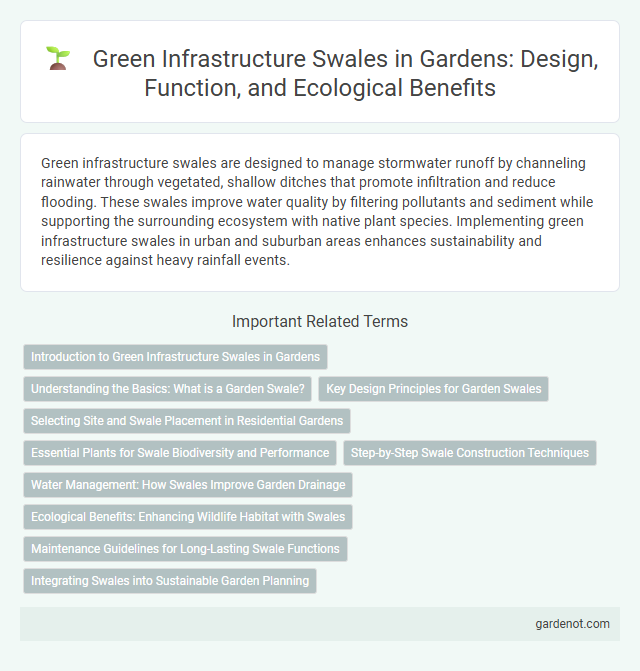Green infrastructure swales are designed to manage stormwater runoff by channeling rainwater through vegetated, shallow ditches that promote infiltration and reduce flooding. These swales improve water quality by filtering pollutants and sediment while supporting the surrounding ecosystem with native plant species. Implementing green infrastructure swales in urban and suburban areas enhances sustainability and resilience against heavy rainfall events.
Introduction to Green Infrastructure Swales in Gardens
Green infrastructure swales in gardens manage stormwater by directing runoff through shallow, vegetated channels that promote infiltration and reduce erosion. These swales use native plants and soils to filter pollutants, improving water quality and supporting local biodiversity. Integrating green infrastructure swales enhances garden sustainability by controlling water flow and mitigating flooding risks.
Understanding the Basics: What is a Garden Swale?
A garden swale is a shallow, vegetated channel designed to capture and infiltrate stormwater runoff, reducing erosion and improving water quality. This green infrastructure technique promotes natural groundwater recharge by slowing water flow and filtering pollutants through soil and plants. Swales are essential for sustainable landscape management, enhancing urban resilience against flooding while supporting biodiversity.
Key Design Principles for Garden Swales
Garden swales prioritize permeability and contour alignment to maximize stormwater infiltration and reduce surface runoff. Incorporating native vegetation enhances soil stabilization and promotes biodiversity, while ensuring a proper slope of 1-3% facilitates optimal water flow without erosion. Effective swale design also includes sediment control measures and access for maintenance to sustain long-term functionality.
Selecting Site and Swale Placement in Residential Gardens
Selecting an ideal site for green infrastructure swales in residential gardens involves evaluating soil permeability and existing drainage patterns to ensure effective stormwater infiltration. Proper swale placement should align with natural contours, avoiding areas prone to waterlogging or structural foundations to maximize water capture and reduce runoff. Incorporating native vegetation within the swale enhances filtration, promotes biodiversity, and improves overall garden sustainability.
Essential Plants for Swale Biodiversity and Performance
Essential plants for green infrastructure swales include native sedges, rushes, and wildflowers that enhance biodiversity and improve water filtration. Deep-rooted species such as Carex spp. and Juncus spp. stabilize soil, promote infiltration, and support aquatic and terrestrial wildlife habitats. Incorporating diverse plant communities maximizes pollutant uptake, reduces runoff velocity, and sustains the ecological performance of swale systems.
Step-by-Step Swale Construction Techniques
Green infrastructure swale construction begins with site assessment and precise grading to ensure proper water flow and retention. Excavation follows, creating a shallow trench that is lined with permeable soil and layered with organic mulch to enhance filtration and promote vegetation growth. Strategic planting of native grasses and plants stabilizes the swale, improves water absorption, and reduces runoff pollution effectively.
Water Management: How Swales Improve Garden Drainage
Green infrastructure swales effectively manage water by directing stormwater runoff away from garden areas, reducing soil erosion and preventing waterlogging. These shallow, vegetated channels enhance infiltration, allowing rainwater to percolate into the ground and recharge groundwater supplies. By controlling surface water flow, swales improve garden drainage, promoting healthier plant growth and reducing the risk of flooding.
Ecological Benefits: Enhancing Wildlife Habitat with Swales
Green infrastructure swales provide critical ecological benefits by creating diverse habitats that support local wildlife, including pollinators, amphibians, and bird species. These vegetated channels enhance biodiversity by filtering pollutants and offering nesting and foraging grounds within urban and suburban landscapes. Swales improve water quality and soil health, contributing to resilient ecosystems and promoting natural groundwater recharge.
Maintenance Guidelines for Long-Lasting Swale Functions
Regular inspection and removal of debris, sediment, and invasive vegetation are essential for maintaining green infrastructure swales' functionality. Ensuring proper grading and repairing erosion prevent water pooling and promote effective stormwater infiltration. Seasonal monitoring of soil permeability and vegetation health supports the swale's long-term performance in managing runoff and improving water quality.
Integrating Swales into Sustainable Garden Planning
Green infrastructure swales enhance sustainable garden planning by efficiently managing stormwater runoff and promoting groundwater recharge. Integrating swales with native vegetation improves soil permeability and supports biodiversity within urban landscapes. Properly designed swales reduce erosion, filter pollutants, and create aesthetically pleasing garden features that contribute to long-term environmental health.
Green infrastructure swale Infographic

 gardenot.com
gardenot.com